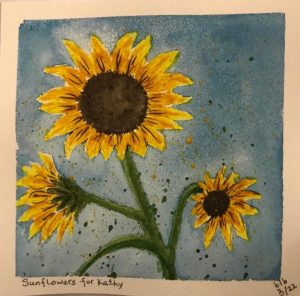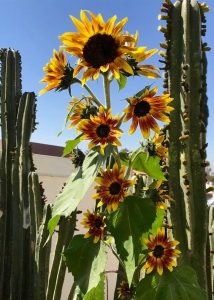Girasol is the Spanish word for sunflower – that tall, strong, proud flower notable for turning its face toward the sun – from the verb girar, to turn, and the noun el sol, the sun. (Similarly, the French word for sunflower is tournesol, from the verb tourner, to turn.) Since the invasion of Ukraine by Russia this past week, people around the globe have been turning their attention to this, the national flower of Ukraine, and seeing it, perhaps for the first time, as a symbol of strength, determination, resilience, and hope.
As London-based journalist Jennifer Hassan wrote in the Washington Post this week, “In recent days, people around the world have been adding bright yellow sunflower emoji to their social media profiles and wearing sunflowers in their hair and on their clothing. Some are planting sunflower seeds…. Artists are painting sunflowers, and those who once visited Ukraine and its endless fields of yellow sunflowers are sharing photographs of the scenes they captured there.”

Some members of the international online watercolor group I belong to [google: Lois Davidson Art] have been painting poignant watercolors of this striking flower, both realistic and abstract, this week. I, too, have been painting sunflowers every evening, in an effort to improve my watercolor skills — and in solidarity with Ukraine.

Flowers, we all know, cannot stop bombs or bullets. But what this majestic flower symbolizes – especially determination and resilience – can. Now when I look at sunflowers I see metaphors for strength.
A year ago at this time, in the garden of my previous apartment here in San Miguel de Allende, Mexico, I was surprised by the towering sunflowers that grew where I’d casually tossed some seeds not long before. Their stalks, as thick as broom handles, grew taller than I; their joyful, yellow-petaled flowers, as big as my face. And, yes, these sturdy, resilient plants spent their day, I observed, slowly tracking the sun, a behavior called heliotropism, from which they obviously derived their strength.

Sunflowers, I learned, originated in the Americas in 1,000 B.C. and have been cultivated for centuries as a valuable food source. With the European exploration of the New World, the flower’s popularity spread, as the rest of the world began to appreciate its beauty and sustenance. Today, according to the website proflowers.com, the sunflower “remains a highly recognized flower, admired for its sunny charm and delightful disposition. These beauties are also still sourced for their seeds, as well as oils used for cooking and skin emollients.”
I also learned that among their many other attributes and symbolisms, sunflowers represent peace as well. When the Soviet Union broke apart in 1991, the then-new nation of Ukraine held the third-largest arsenal of nuclear weapons. In 1996 Ukraine committed to total nuclear disarmament; and to honor the occasion, representatives from the United States, Ukraine, and Russia planted sunflowers where nuclear missile silos had been.
Now Russia is threatening to use nuclear weapons in its new war of unprovoked aggression against Ukraine. Saber-rattling is one thing, but rattling nuclear weapons is quite another, in my view. The whole world should be alarmed.
I, for one, choose to take a lesson from Ukraine’s national flower and look to the light for resilience, strength, and hope. Call me Girasol.
This Howard Zinn quote I found on Facebook the other day helps to express my stance: “…The future is an infinite succession of presents, and to live now as we think human beings should live, in defiance of all that is bad around us, is itself a marvelous victory.”
